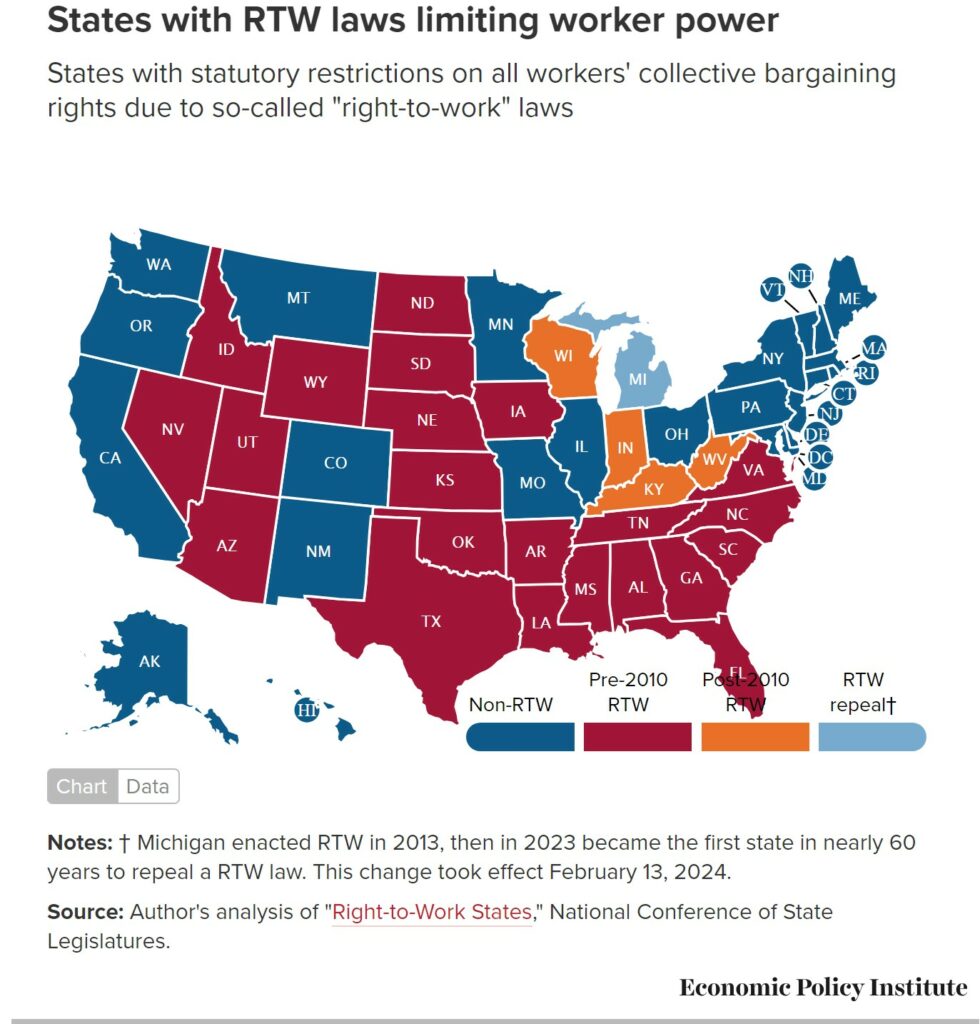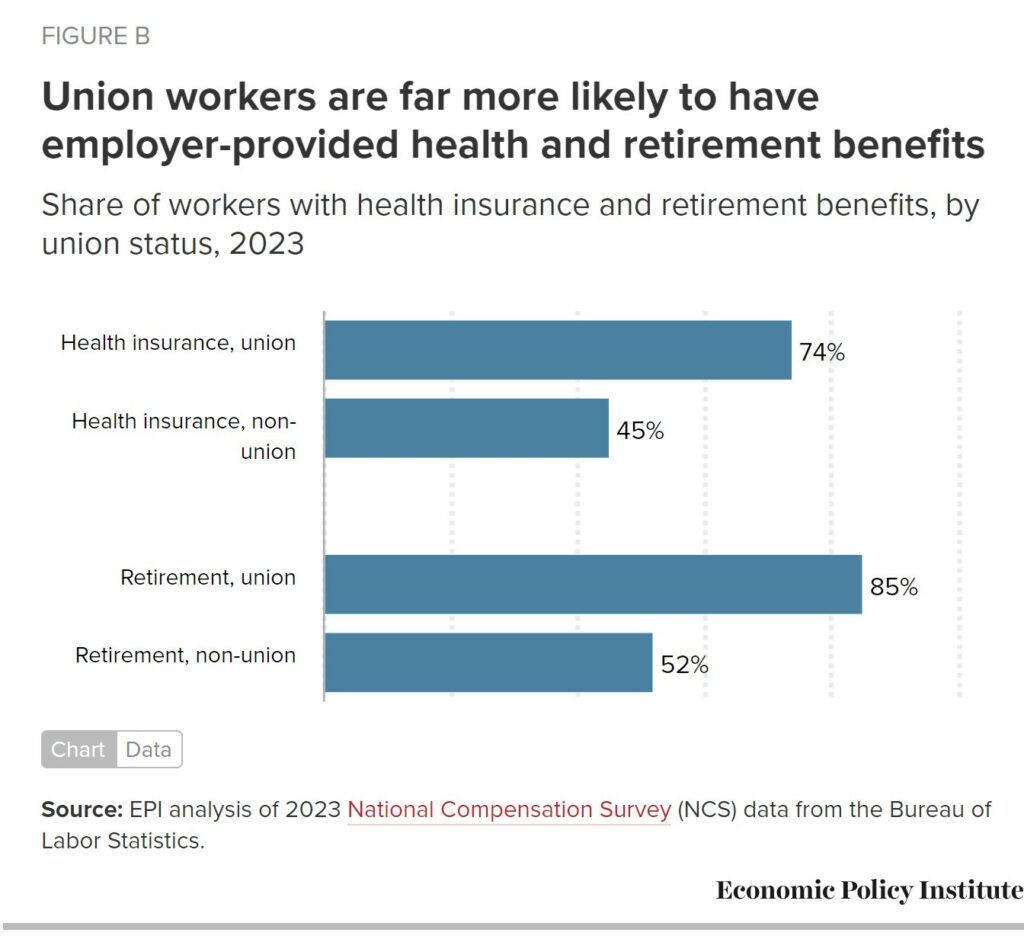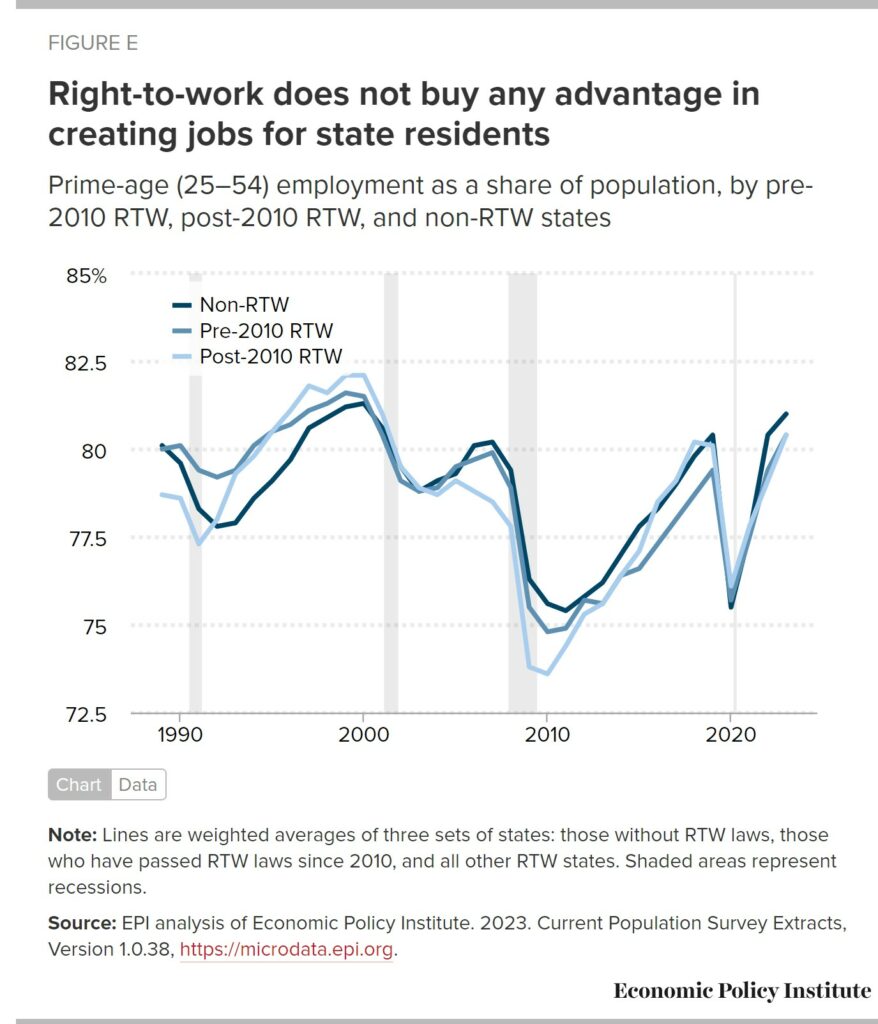Data shows anti-union ‘right-to-work’ laws damage state economies
I believe Angry Bear has touched upon Right to Work several times now; here, here, and now today. This brief touches upon RTW laws damaging state economies.
Data show anti-union ‘right-to-work’ laws damage state economies: As Michigan’s repeal takes effect, New Hampshire should continue to reject ‘right-to-work’ legislation,
Economic Policy Institute,
Jennifer Sherer and Elise Gould, February 20, 2025
Key findings:
- Data show that states with so-called “right-to-work” (RTW) laws have lower unionization rates, wages, and benefits compared with non-RTW states.
- On average, workers in RTW states are paid 3.2% less than workers with similar characteristics in non-RTW states, which translates to $1,670 less per year for a full-time worker.
- Claims that weakening unions will lead to state job growth have proven inaccurate. There are no measurable employment advantages between RTW and non-RTW states.
This week, Michigan’s 2023 repeal of a so-called “right-to-work” (RTW) law takes effect. Meanwhile, New Hampshire’s state legislature is once again debating a RTW bill at a moment when it could not be clearer that RTW laws damage states’ economies by accelerating income inequality and reducing job quality, without delivering any job growth.
RTW laws—and the phrase “right to work” itself—are intended to deceive and confuse. The misleadingly named policy is designed to make it more difficult for workers to form and sustain unions and negotiate collectively for better wages, benefits, and working conditions.
As Martin Luther King, Jr. pointed out in 1961, “right to work” is a “false slogan” since RTW laws provide neither rights nor work and are in fact designed “to rob us of our civil rights and job rights [and] to destroy labor unions and the freedom of collective bargaining by which unions have improved wages and working conditions of everyone.” Decades later, research bears out King’s contention . . .
“wherever these laws have been passed, wages are lower.”
RTW laws are historically rooted in racism and designed to maintain unequal power. When private-sector workers first gained legal protection to unionize following passage of the federal National Labor Relations Act in 1935, unionization rates grew quickly. In response, opponents waged anti-union, explicitly white supremacist campaigns to limit worker power and maintain Jim Crow labor relations. These campaigns pursued state legislation as a means to constrain workers’ newly won federal union rights via RTW policies, and especially to block multiracial union organizing. RTW laws have since spread to 27 states and continue to generate economic outcomes disadvantaging all workers.
Figure A shows that Southern and Western states adopted the majority of RTW laws in the mid-twentieth century. But since 2010, five additional states with historically above average unionization rates—Indiana, Kentucky, Michigan, West Virginia, and Wisconsin—adopted RTW laws, newly limiting workers’ collective bargaining rights in those states.
Michigan became the first of these states to repeal its RTW law.
Right-wing groups similarly targeted New Hampshire for passage of RTW in 2011, when then-Governor John Lynch vetoed a RTW bill passed by the legislature. New Hampshire has since remained a perennial target for anti-union proposals, with RTW bills rejected at least seven times since 2010. Most recently, the New Hampshire House voted down a 2021 RTW proposal.
No New England state has a RTW law, and repeated defeats of RTW have demonstrated its persistent unpopularity among New Hampshire voters and legislators across party lines. Moreover, RTW has faced three consecutive rejections in other states:
Michigan repealing RTW in 2023, Illinois voters approving a constitutional Workers’ Rights Amendment (which bans future RTW laws) in 2022, and Missouri voters overwhelmingly rejecting their legislature’s attempt to impose RTW restrictions in 2018.
Nonetheless, in 2024, some well-funded, out-of-state anti-union groups continue to demonstrate relentless interest in using state legislatures as vehicles to attack workers’ rights, and RTW was one of the first bills introduced by House Republicans in New Hampshire’s legislative session.
Below, we share the latest data assessing the economic impacts of RTW laws, including in the five states where the law was most recently adopted, illustrating why New Hampshire has been right to repeatedly reject RTW and why lawmakers should do so again in 2024.
So-called “right-to-work” laws constrain workers’ collective bargaining rights, resulting in lower wages and benefits for all workers
RTW laws are designed to diminish workers’ collective power by prohibiting unions and employers from negotiating union security agreements into collective bargaining agreements, making it harder for workers to form, join, and sustain unions. As a result, states with RTW laws generally have lower unionization rates than non-RTW states. Private-sector workers in RTW states are less likely to be covered by a union contract than peers in non-RTW states. This, even after controlling for other factors that can be related to unionization (such as industry, occupation, education, age, gender, race, ethnicity, and foreign-born status).
Consequently, workers in states with RTW laws have lower wages, reduced access to health and retirement benefits, and higher workplace fatality rates. On average, workers in RTW states are paid 3.2% less than workers with similar characteristics in non-RTW states, which translates to $1,670 less per year for a full-time worker.1
Figure B illustrates that unionized workers are 64% more likely to have employment-provided health insurance and 63% more likely to have employment-provided retirement benefits than their non-union counterparts. About 80% of union workers have employer-provided health and retirement benefits compared with only about half of non-union workers.
By weakening unions, “right-to-work” laws fuel economic inequality
State policies like RTW constraining workers’ rights to unionize and collectively bargain are fundamentally linked to key economic and labor market outcomes—including measures of inequality. Data show unions reduce income inequality across the economy, counteract racial and gender labor market inequities, and reduce public-sector pay gaps.
Through bringing workers’ collective power to the bargaining table, unions are able to win better wages and benefits for working people—reducing income inequality as a result. As shown in Figure C, there was less income inequality in decades when union density was higher. But as unionization rates declined—particularly after 1979—income inequality grew.
The erosion of collective bargaining over the last five decades suppressed workers’ wages. Median wages would be 7.9% higher if unionization hadn’t declined between 1979 and 2017. This translates into over $3,900 annually in lost wages for a full-time worker.2
Figure D shows changes in unionization rates broken down by RTW status, differentiating between states adopting RTW either before or after 2010. Unionization has declined far more sharply in the states that adopted RTW most recently, falling 3.8 percentage points between 2010 and 2023. But unionization rates remain lowest in states that have long had RTW laws in place. Overall, unionization rates were 5.0% in states that had adopted RTW prior to 2010, 9.7% in states that adopted RTW after 2010, and 14.3% in non-RTW states.
In New Hampshire, union membership held fairly steady during this period, dropping only 0.9 percentage points between 2010 and 2023. The New Hampshire unionization rate was 9.3% in 2023, just below the national average of 10.0%. If New Hampshire adopted RTW, they could expect to risk similarly accelerating declines in union membership and increasing income inequality.
“Right-to-work” laws erode job quality without creating job growth
Despite persistent claims from RTW proponents that weakening unions will lead to state job growth, comparisons of RTW and non-RTW states over decades show no relationship between employment levels and RTW laws. Figure E illustrates the prime-age employment-to-population ratio—the share of the population ages 25–54 with a job—has no clear differences among three sets of states: those that have remained non-RTW, those that adopted RTW before 2010, and those that adopted RTW after 2010. Employment trends across all sets of states reflect fluctuations within business cycles; recessions are shaded in grey. There are no measurable employment advantages between RTW and non-RTW states.
Prior studies have likewise shown no causal link between a state’s RTW status and its job growth. For example, studies of Oklahoma after the state enacted RTW in 2001 found a significant reduction in private-sector unionization, but no measurable effect on employment growth. Similarly, researchers at the University of Kentucky examined state economic performance across Southern U.S. states from 1964 to 2004 and found that RTW status had no relationship to state economic outcomes. When studies have claimed to find such effects, it is often due to failure to control for other critical factors, such as education levels of the workforce, proximity to transportation hubs, technological advances, or natural resources.
New Hampshire should continue to reject RTW and the economic damage it inflicts on states
At a moment of historic inequality and record corporate profits, it is no surprise we are also seeing historically high levels of approval for unions. Workers are looking to unions as critical vehicles for fixing what’s broken at work and in our wildly unequal economy. The large gap between the share of workers who want a union and the share of workers who are in a union underscores that our weak federal labor laws, which are further undermined by RTW measures in over half of U.S. states, are not working. Because state RTW laws diminish workers’ rights, weaken unions, and further concentrate corporate power, they are the opposite of what states need to address chronic economic problems of widening inequality and eroding job quality.
Fundamental reform of our labor laws is required to rebuild an economy that guarantees all workers the freedom to unionize and collectively bargain, and no longer leaves most workers behind. At the state level, this reform must include repeal of existing RTW laws across the country, and continued rejection of new RTW proposals in states like New Hampshire.
Notes
1. This difference is based on a regression model which accounts for demographic differences (e.g. gender, age, marital status, race/ethnicity, and education), individual labor market controls (e.g. full-time status, hourly status, union status, occupation, and industry), state-level labor market controls (e.g. unemployment rate), and three measures that account for differences in the cost of living between RTW and non-RTW states. The 3.2% difference in average wages is applied to an average wage of $23.98.
2. Here, we are extrapolating from 2017 applying the 7.9% difference to the median hourly wage of $23.98 in 2023. For a full-time worker, this yields a difference of $3,940 per year. Further, this is likely a lower bound given the continued decline in unionization of 0.8 percentage points since 2017.






It would seem that the 27 states that maintain ‘right-to-work’ laws are all of the GOP-controlled ‘red states’. Go figure!